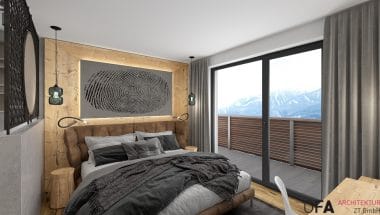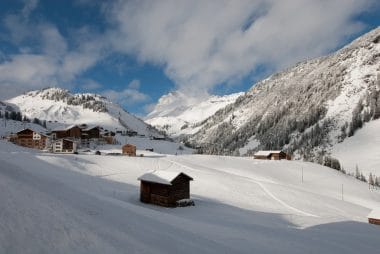
Cosy inns, sun and snow and a view as far as the eye can see – the Arlberg region makes the hearts of winter sports enthusiasts beat faster. But it’s not just alpine sports enthusiasts who rejoice on the Arlberg and indulge in après-ski – those seeking relaxation will find silence and experiencing nature in its purest form. At the foot of the jagged Lechtal Alpine ridges, active holidaymakers will find a rich field of activity in summer and winter and families will find tranquil holiday idylls.
Between rugged rock and gentle hilltops
The once feared Alpine bottleneck around the Arlberg now turns out to be a fabulous mountain route that leads from St. Anton in the Tyrolean Stanzertal over the Alberg Pass to Stuben in the Klostertal.
Known? In ancient times, anyone who wanted to travel from Tyrol to Vorarlberg had to conquer the pass via a mule track. Kings, popes and countless pilgrims to Santiago were among them. Avalanches often killed hikers. It was not until the end of the 18th century that a road replaced the simple mountain route.

It is particularly relaxing to spend your holiday in a lodge on the Arlberg in Austria . This is an excellent combination of pleasant luxury and the tranquillity of the mountains. Whether families with children or single couples. The lodges offer all the comfort you could wish for on an Arlberg holiday.
And that’s how they came about, the well-known winter sports resorts around the Arlberg…
The Arlberg is located on the border between Vorarlberg and Tyrol. It is the highest massif in the Lechtal Alps and forms the watershed between the Rhine and Danube – making the mountain range a weather divide at the same time. This in turn means that large amounts of snow regularly fall there in winter. Statistically proven, larger amounts of snow fall from the sky on the Arlberg than elsewhere. This resulted in a number of well-known winter sports resorts such as St. Anton, Lech, Zürs and Stuben. The entire massif was covered with numerous mountain railways and hundreds of T-bar lifts. In summer, hikers use many of these cable cars and lifts to reach the heights of the mountains – including the all-towering Valluga at 2811 meters.
Good to know: Arlberg is the ski area between Valluga, Albonagrat, Mohnenfluh and Hoher Riffler.
Finally, in 1978, the opening of the road tunnel sealed the eventful history of Arlberg as a pass crossing. If you want to leave the Arlberg behind quickly, take the 14-kilometre-long Arlberg road tunnel.
The most beautiful holiday spots on the Arlberg
Warth am Arlberg
Located in the centre of three valleys, Warth am Arlberg offers pure relaxation away from the hustle and bustle of the big winter sports resorts. With just 400 inhabitants, Warth is the right place to recharge your batteries. Not to forget: Warth is one of the most snow-sure areas in the Alps.
St. Anton

There is no doubt that St. Anton is a “winter great”. But a little of it can also be experienced in summer – best during a visit to the ski and local history museum. St. Anton is probably a household name. The place is considered the cradle of alpine skiing as well as a meeting place for snow-hungry high society and the European aristocracy. At the World Village, as it is also affectionately called, the mixture of alpine tradition and international flair is fascinating. Thanks to the tunnel opened in 1978, the center is a traffic-free pedestrian zone, in which it is pleasant to stroll and shop.
St. Christoph
Like St. Anton, the somewhat more elitist St. Christoph also unfolds its best qualities in winter. The former hospice for the care of travellers over the Arlberg Pass became an exclusive ski resort in the 20th century. The success story of the winter sports resort began in 1901 with the founding of the ski club. After an eventful day of skiing, you can enjoy cosiness and culinary delights at the host of the St. Hospice.
Snow magic in Lech am Arlberg!
Located just over 1000 meters above sea level, the small town of Lech presents itself almost kitschy beautiful. The white water of the Lech ripples through the village. The centre of Lech is dominated by the old village church, whose onion dome reflects the sunlight. The whole thing is framed by lush green high-altitude greenery and picture-book lakes dabbed into it. Skiers, mountain hikers and families give the region the title “dreamlike”.
Oberlech
Despite its many guests, the village has retained its traditional architectural style and is still cozy. In addition, many secured powder slopes allow deep snow descents. The “Haus Feuerstein” offers beautiful holiday apartments with a great view on the slope and direct access to the Oberlech ski area. Wonderful hiking trails start on the doorstep.
Zürs an der Flexenstraße
From a mountain village to a world-famous winter sports centre – the village in the traffic jam of the Arlberg enjoys a special abundance of snow. During the ski season, there are many opportunities for downhill and cross-country skiing.
By the way: More than 30 cable cars and lifts, including the Kapal, Valluga, Nasserein, Schindlergrat and the glass-futuristic Galzigbahn, open up the local mountains and connect them with the extensive skiing and hiking areas, especially Zürs and Lech.
Those who like it less turbulent will feel right at home in Stuben or in Langen am Arlberg.
Culinary highlights around the Arlberg
The Arlberg’s gastronomic map is peppered with addresses steeped in history, whose operators devotedly cultivate the tradition of authentic cuisine and hospitality. Wood-panelled parlours, often under old vaults, form the cosy setting for hearty culinary delights.
Tip for a cosy stop: The Verwallstube of St. Anton is a noble restaurant, 2085 meters above sea level and known for its fish specialties. On Thursday evening, guests enjoy a romantic dinner with live piano music. The view of the mountains should also be mentioned: the slopes around Patteriol and Valluga are within reach!
And then there is the land in front of it: Vorarlberg, the land in front of the Arlenberg – the pass that is overgrown with alders – declares itself to be the smallest province in Austria in terms of population and the second smallest in terms of area. Celts, Romans and Allemanni left behind valuable testimonies of a culture that was several thousand years old. Tracing their works in the Ländle is at least as interesting as hiking the peaks or succumbing to the fascination of skiing in winter.
Facts about the ski resort Arlberg
The Arlberg is one of the largest and best-known ski resorts in Austria and stretches across the provinces of Tyrol and Vorarlberg. Here are the most important facts and information that skiers should know about the Arlberg ski area:
1. Location and accessibility
- Geographical location: The Arlberg includes well-known ski destinations such as St. Anton, Lech, Zürs, Stuben, Warth and Schröcken. These resorts are located in Tyrol and Vorarlberg and are connected by an extensive network of lifts and slopes.
- Accessibility: The Arlberg is easily accessible by car, but also via train connections (train stations in St. Anton and Langen am Arlberg). International guests can arrive via the airports in Innsbruck, Zurich or Munich.
2. Slope length and variety
- Total length of slopes: The Arlberg offers a total of around 305 kilometres of groomed slopes as well as an additional 200 kilometres of marked ski routes.
- Schwierigkeitsgrade:
- Blue slopes (easy): approx. 130 km
- Red slopes (medium): approx. 123 km
- Black slopes (difficult): approx. 52 km
- Altitude: The slopes are located between 1,300 and 2,811 meters above sea level, which ensures snow-sure conditions.
3. Lifts and facilities
- Number of lifts: There are a total of 88 lifts, including modern gondola lifts, chairlifts and T-bar lifts.
- Infrastructure: The Arlberg ski area is known for its state-of-the-art infrastructure. The lifts are fast and efficient, which avoids long waiting times. Special highlights are the Flexenbahn and the Galzigbahn.
4. Ski season
- Duration: The ski season usually starts at the end of November and lasts until the end of April.
- Snow reliability: The Arlberg is very snow-sure due to its altitude and extensive snow-making facilities. In addition, an average of 7 metres of fresh snow per year provides ideal conditions.
5. Special highlights
- The White Ring: A famous ski circuit that connects Lech, Zürs and Zug and covers about 22 kilometres. This loop is a must for skiers who want to explore the entire region.
- The Run of Fame: This ski circuit leads over 85 kilometres across the entire Arlberg region and allows skiers a day full of variety and panoramic views.
- Freeride paradise: The Arlberg is internationally known for its excellent freeride opportunities, including deep snow areas and untouched slopes for experienced skiers.
6. Freeride and off-piste
- Freeride options: The Arlberg offers exceptional off-piste opportunities and deep snow runs. There are special freeride workshops and guided tours to discover the best spots.
- Avalanche safety: There are state-of-the-art safety precautions throughout the ski area and a well-developed avalanche warning system to ensure safety for freeriders.
7. Snow parks and freestyle
- Snow park in Lech: The snow park in Lech offers various lines for beginners to professionals, with kickers, rails and boxes. It is the perfect place for snowboarders and freestylers who are looking for variety.
8. Infrastructure and gastronomy
- Huts and mountain restaurants: The Arlberg offers a variety of huts and restaurants that offer regional Tyrolean and Vorarlberg specialities as well as international cuisine. The “Rud-Alpe” in Lech and the “Verwallstube” in St. Anton are particularly popular.
- Equipment rental: There are numerous rental stations for ski equipment and safety equipment in all towns on the Arlberg.
- Parking: There are plenty of parking spaces in the valley as well as shuttle buses that connect the ski areas with each other.
9. Family-friendliness
- Ski schools: The Arlberg offers numerous ski schools with courses for children and adults, beginners and advanced skiers.
- Children’s areas: Special practice areas, such as the children’s area in Lech and St. Anton, are ideal for families and allow children to learn through play.
10. Après-ski and leisure activities
- Après-ski: The Arlberg is famous for its après-ski offerings, especially in St. Anton. The “MooserWirt” and the “Krazy Kanguruh” are among the most famous après-ski locations in the Alps.
- Other leisure activities: Winter hiking trails, cross-country ski trails and toboggan runs offer additional leisure opportunities.
11. Special tips for skiers
- The “Schindlergratbahn”: This lift system takes skiers to breathtaking panoramic slopes and freeride routes.
- Early skiing: In the morning, many slopes on the Arlberg are less frequented, ideal for skiers who want to enjoy a quiet start to the day.
12. Accommodation
- Hotels and guesthouses: The Arlberg offers accommodation for every budget – from simple guesthouses to luxurious 5-star hotels.
- Ski-in/ski-out: Many accommodations in St. Anton, Lech and Zürs allow direct access to the slopes, which makes your stay particularly comfortable.
13. Weather conditions
- Snow reliability: The altitude and the abundance of natural snowfall make the Arlberg particularly snow-reliable.
- Sunny days: Many sunny days offer ideal conditions for skiing and beautiful panoramas of the surrounding Alps.

